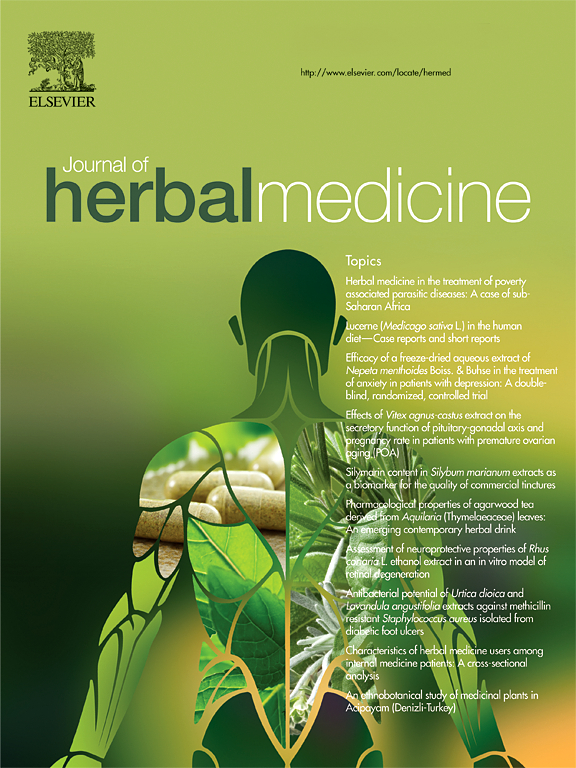Traditional herbal practices associated with malaria and symptoms: Mishmi tribe cohort study from Arunachal Pradesh, Northeast India
IF 1.9
4区 医学
Q2 INTEGRATIVE & COMPLEMENTARY MEDICINE
引用次数: 0
Abstract
Introduction
The Miju-Mishmi tribe of Lohit district, Arunachal Pradesh has a long-standing tradition of utilising herbal remedies for treating various ailments, including malaria. This study aimed to explore the antimalarial plants traditionally utilised by the Miju-Mishmi tribe, their preparation methods, and the biological significance of these remedies through phytopharmacological analysis.
Methods
The three villages of Karhe, Ziro Basti and Telluliang in Arunachal Pradesh were selected as study sites which spanned from April 2020 to July 2021. A group of people, including knowledgeable elders, traditional healers, herb vendors, and patients, who had been treated, were interviewed using semi-structured interviews and focus groups. In order to measure the efficacy and popularity of medicinal plants, ethnobotanical indices were computed. These included Fidelity Level, Preference Ranking, Use Value, Informant Consensus Factor, and Formulation Score.
Results and discussion
A total of 79 medicinal plants from 50 families and 71 genera, with 24 plants being newly identified for their antimalarial properties. Predominantly, leaves (30.38%) of herbaceous species (48.10%) were commonly used, with direct oral consumption being the highest preferred mode of administration (83.54%), primarily through extraction (25.81%) and decoction (22.58%). Notably, Aconitum heterophyllum demonstrated the highest fidelity value (≥80%), while Coptis teeta exhibited the highest Preference Ranking (≥65%). The Use Value index ranged from 0.07 to 0.87. Qualitative phytochemical profiling of selected plants confirmed their therapeutic efficacy against malaria.
与疟疾和症状相关的传统草药疗法:印度东北部阿鲁纳恰尔邦米什米部落队列研究
Lohit地区的Miju-Mishmi部落**有使用草药治疗包括疟疾在内的各种疾病的悠久传统。本研究旨在通过植物药理学分析,探索Miju-Mishmi部落传统使用的抗疟植物及其制备方法,以及这些药物的生物学意义。方法于2020年4月至2021年7月,选择**省Karhe、Ziro Basti和tell梁3个村作为研究地点。一群人,包括知识渊博的长者、传统治疗师、草药供应商和接受过治疗的病人,使用半结构化访谈和焦点小组进行了采访。为了衡量药用植物的功效和普及程度,计算了民族植物学指数。这些指标包括保真度水平、偏好等级、使用价值、知情者共识因子和表述得分。结果与讨论共获得50科71属79种药用植物,其中新鉴定抗疟植物24种。以草本植物叶(30.38%)为主(48.10%),直接口服给药比例最高(83.54%),其次为提取(25.81%)和煎煮(22.58%)。其中,乌头(Aconitum heterophyllum)保真度最高(≥80%),黄连(Coptis teeta)最高(≥65%)。使用价值指数范围为0.07 ~ 0.87。所选植物的定性植物化学分析证实了它们对疟疾的治疗效果。
本文章由计算机程序翻译,如有差异,请以英文原文为准。
求助全文
约1分钟内获得全文
求助全文
来源期刊

Journal of Herbal Medicine
INTEGRATIVE & COMPLEMENTARY MEDICINE-
CiteScore
3.90
自引率
0.00%
发文量
94
期刊介绍:
The Journal of Herbal Medicine, the official journal of the National Institute of Medical Herbalists, is a peer reviewed journal which aims to serve its readers as an authoritative resource on the profession and practice of herbal medicine. The content areas of the journal reflect the interests of Medical Herbalists and other health professionals interested in the clinical and professional application of botanical medicines. The objective is to strengthen the research and educational base of herbal medicine with research papers in the form of case studies, original research articles and reviews, monographs, clinical trials and relevant in vitro studies. It also publishes policy statements, opinion pieces, book reviews, conference proceedings and profession related information such as pharmacovigilance reports providing an information source for not only the Herbal Practitioner but any Health professional with an interest in phytotherapy.
 求助内容:
求助内容: 应助结果提醒方式:
应助结果提醒方式:


